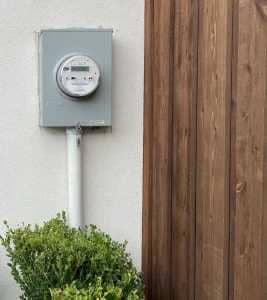What is solar net metering?
Texans who have solar panels installed, have the potential to receive electric bill energy credits in kilowatt-hours (kWh), by selling their excess solar energy to the grid when the sun is shining and their home is using less energy(electricity) than what is being produced by the solar panels.

The Process of Saving Money With Solar Buyback
How this works is that during the day while the sun is shining, solar energy is produced by the solar panels. The solar energy is first consumed by the owner who has solar panels installed on their property. Whatever solar energy the owner does not use then feeds into the electric grid. This is where net metering solar buyback credits are obtained, by the solar energy going through the owners’ electric utility meter and then into the greater grid network.
These energy credits are then used to offset the owner’s electric utility bill, which is the main way that solar owners receive financial compensation for the investment they’ve made into going solar. These electric bill credits can be the main deciding factor for people who decide to go solar strictly to save money.

Setting Up Solar Buyback Net Metering To Save On Electricity Cost
During the process of installing a solar system, the customers must sign an interconnection agreement that allows them to feed solar energy to the grid. Owners can then sign up for a net metering program with an electric utility company that buys their excess electric energy produced by the solar panels. The rates and amount of credit they receive will depend on a few factors. These factors include; size of the solar system, estimated energy offset (electric energy consumption vs produced solar energy), and the different rate structures provided by the electric utility companies.
Uncertainty of Solar Net Metering Programs
Unfortunately for Texans, net metering solar buyback programs and credits are not guaranteed. This is because Texas has a deregulated grid market. This means that in Texas, electric utility companies are not legally obligated to provide incentives or net metering to its customers. This can put solar homeowners at a disadvantage due to not having credits that would otherwise assist in recouping the financial cost of the solar investment. However, currently there are still electric utility companies across Texas that still do offer net metering programs and credits. The availability and credit rates will vary in different areas and from the utility companies throughout the state of Texas.
Protection From Unfavorable Net Metering Rates
One way to protect yourself from unfavorable solar buyback plans is to invest in an ESS (energy storage system), such as a Tesla Powerwall. Batteries installed with solar panels will provide more of a secured return on investment. That is because batteries provide the capability to store the excess solar energy produced during the day that would normally feed into the grid. The stored energy can then be consumed at a later time for when the sun isn’t shining, or whenever more energy is needed to offset electrical consumption that would normally be drawn from the grid.
In addition to having a form of backup power like a generator, with a Tesla Powerwall or other ESS, it provides consistent reliability that ensures maximum utilization and value of the solar panels. Therefore being the best solution for going solar in Texas.

Get a Quote:
Solar Metering
Solar net metering policy and implementation in Texas is an ever changing environment that will not be consistent as time goes on. It is possible that in the future, Texas policy makers and electric utility companies will stop and take away programs that provide any incentives or credits for solar owners. Therefore it is important to understand that one cannot rely on Texas net metering programs to be a consistent gauge for return on investment on solar.

The real value in solar for Texans will be the ability to become more energy independent. The cost of electricity in Texas will also be rising as utility companies pass their cost of using fossil fuels to generate electricity to consumers. People can hedge against the rising cost by having solar panels paired with an ESS system. This is how Texans can maintain true energy independence and sovereignty.
There are certain areas on the Texas grid, referred to as electric distribution “Co-Ops” that are setup as non-for-profits and design their own rates for how they buyback surplus solar energy. This can be hard to keep track of, since there are over 64 electric distribution Co-Ops in the state of Texas. You might also live in an area where the City owns the electric distribution network. The key point here is, make sure you fully understand how you’re going to get credit for your solar energy credits, because this can ultimately make or break your solar customer experience.
Texans can also make change by engaging with solar advocate groups and nonprofits that work with policy makers to help provide more friendly policies for going solar.
Sources and Articles to link:
https://www.solarunitedneighbors.org/
https://www.texaspowerguide.com/solar-buyback-plans-texas/
https://quickelectricity.com/2018-solar-panel-incentives-texas-net-metering-buyback-programs/
https://www.solarreviews.com/blog/texas-net-metering-complete-guide
Fact checked by Jacob Petrosky – 4/26/2024